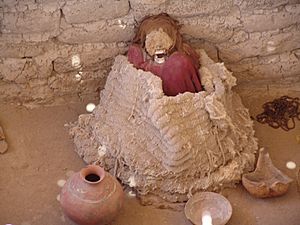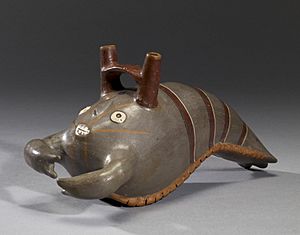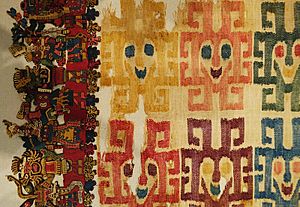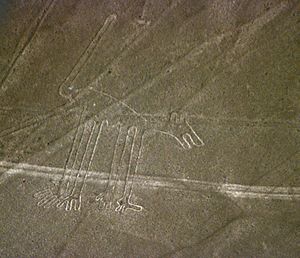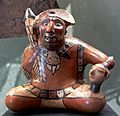Nazca culture facts for kids
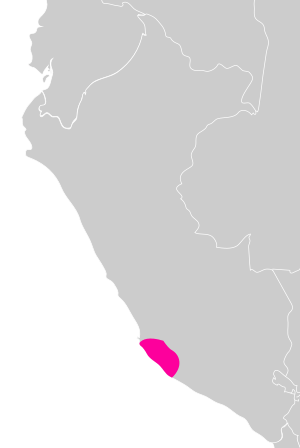
Area of control and influence of the Nazca.
|
|
| Period | Early Intermediate |
|---|---|
| Dates | 100 BCE – 800 CE |
| Preceded by | Chavín culture, Paracas culture |
| Followed by | Wari culture |
The Nazca culture (also called Nasca) was an ancient civilization. It thrived from about 100 BC to 800 AD. They lived along the dry southern coast of Peru. Their homes were in the river valleys of the Rio Grande de Nazca and the Ica Valley. The Nazca people were greatly influenced by the earlier Paracas culture. The Paracas were famous for their amazing textiles. The Nazca also created many crafts and technologies. These included beautiful pottery, textiles, and huge desert drawings called geoglyphs.
They are well-known for two massive building projects. These projects needed many workers to cooperate. One project was the Nazca Lines. These are giant designs in the desert. Their purpose is still a mystery. The other project was the puquios. These were underground aqueducts. They brought water for farming and daily use in the dry land. Many of these puquios still work today. The Nazca Province in the Ica Region is named after this ancient people.
Contents
History of the Nazca People
When Did the Nazca Live?
The Nazca society grew during a time called the Early Intermediate Period. Experts divide their history into different stages:
- Proto Nazca (Phase 1): Around 100 BC to 1 AD. This was the very beginning.
- Early Nazca (Phases 2–4): From 1 AD to 450 AD.
- Middle Nazca (Phase 5): From 450 AD to 550 AD.
- Late Nazca (Phases 6–7): From 550 AD to 750 AD.
Why Did the Nazca Civilization End?
Around 500 AD, the Nazca civilization began to weaken. By 750 AD, it had completely fallen apart. Scientists believe this happened because of a strong weather event called El Niño. This event caused widespread and damaging floods.
Evidence also suggests that the Nazca people made the floods worse. They slowly cut down Prosopis pallida trees. They did this to make more space for growing corn and cotton. These trees were very important for the environment. They helped stop rivers and wind from eroding the land. Removing the trees left the land open to the effects of El Niño. This led to more erosion. Their irrigation systems were left without water.
Nazca Society and Life
How Was Nazca Society Organized?
Early Nazca society was made up of local leaders called chiefdoms. There were also important regional centers. One main center was Cahuachi. This was a special ceremonial site, not a city. It had earthwork mounds and open plazas.
Scholars have studied Cahuachi a lot. They think it was a place for important rituals and feasts. These events were likely about farming, water, and fertility. Cahuachi is in the lower part of the Nazca Valley. It was first used during the late Paracas culture period. It is the most important site for learning about ancient Nazca culture. The people shaped natural hills, called huacas, into pyramid mounds for religious events.

Digging at Cahuachi has given archaeologists important clues about the culture. They found lots of colorful pottery and fancy textiles. They also found small amounts of gold and spondylus shells. Many ritual items were also discovered.
The pottery found at Cahuachi suggests it was a ceremonial site, not a city. About 70% of the pottery was fine and colorful. Only 30% was plain, everyday pottery. If it were a city, there would likely be more everyday pottery. They also found food remains like maize, squash, beans, peanuts, and some fish.
Building at Cahuachi stopped. It seems Cahuachi was left empty around the end of Nazca Phase 3 or early Phase 4. Many reasons could explain why Cahuachi was abandoned. Most experts believe it was due to a long drought that affected the whole Andean region. After Cahuachi, Nazca society was still organized similarly. However, they built fewer large structures like those at Cahuachi.
What Did the Nazca Believe In?
The Nazca people lived in a very dry and extreme environment. Because of this, their religious beliefs focused on farming and fertility. Much of Nazca art shows powerful nature gods. These included the killer whale, harvesters, a mythical spotted cat, and a snake-like creature. The most common figure they worshiped was a mythical being that looked like a human.
Religious events and ceremonies happened at Cahuachi. People worshiped the nature gods to help their crops grow. During these times, people from nearby villages would come to Cahuachi. They would take part in feasts. Regular people could get valuable goods, like fancy colorful pottery, through these feasts. In return, the leaders gained more power and status. They also got common people to help with labor and building at the site.
Nazca Economy and Daily Life
How Did the Nazca Get Food?
The Nazca people mainly got their food through agriculture. Designs on their pottery and excavated remains show they ate a variety of foods. Their diet included maize, squash, sweet potato, manioc, and achira. They also ate a small amount of different fish.
They grew other important crops too. These included cotton for making textiles, coca, San Pedro cactus, and gourds. The gourds were often decorated with scenes from daily life. Evidence of cocoa use is seen in remains and pottery designs. The San Pedro cactus was also shown in ceremonies on colorful pots.
For animal resources, the Nazca made sacrifices of llamas and guinea pigs at Cahuachi. Llamas were also used to carry goods. Their wool was used for textiles, and they were eaten for meat.
The Amazing Puquios (Water System)
Around the Middle Nazca period, the Nazca people built an amazing water system. This was needed to survive in their very dry environment. The exact time they built the puquios has been debated. It's hard to date them because of the materials used. Digging them up also destroyed some clues about their age.
The best ways to date them have been by studying a shiny layer on rocks inside the puquios. They also looked at where settlements were built. These methods suggest the puquios were first built during the Middle Nazca period.
The irrigation system used underground channels, called puquios. These channels tapped into water found below the ground. Workers dug the channels into the mountainside until they reached underground water sources. The channels were lined with river rocks. No mortar was used, so water could seep into the channels.
The water was then carried to irrigation canals (acequias) for farming. Or, the water was stored in small reservoirs (kochas) for later use at home. Many access holes, called ojos (eyes), were placed along the channels. People would go down into these ojos to clear blockages or make repairs.
It's hard to know how long these underground channels are. Many puquios have been changed over time. Some are too dangerous to explore underground. Their length is estimated by measuring the distance between the ojos.
Many of these channels are still used today. This shows how important they were to ancient people in the dry desert. Modern people have changed the puquios to work better. They have added motorized pumps. Some kochas have been lined with concrete to hold water better. Some of the best-preserved channels are in Cantalloc.
Nazca Art and Skills
Nazca Pottery: A Splash of Color
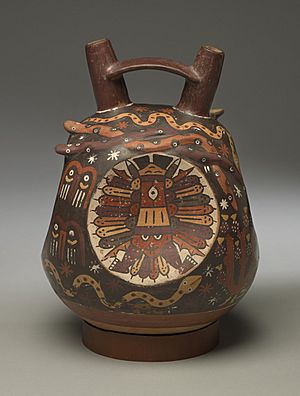
The Nazca culture is famous for its colorful pottery. They used at least 12 different colors to paint their pots. The Nazca started painting their pottery before firing it. This was different from the Paracas culture, which painted after firing. This change marked the start of Nazca pottery.
The Nazca made more pottery than the Paracas. This might be because pottery took less time to make than textiles, which the Paracas preferred. Painting before firing meant artists had to experiment. They learned which paints made certain colors.
Common pottery shapes included double-spout bottles, bowls, cups, vases, and animal or mythical creature shapes. Archaeologists found valuable colorful pottery among all Nazca social classes. This shows that not just rich people had access to them. Common people could get these goods through feasts and visits to Cahuachi. This helped spread the ruling class's culture.
Clay matching the colorful pottery found across the Nazca region was found near Cahuachi. However, there is no strong proof that pottery was made at Cahuachi. The site was likely a place where pottery was distributed to others.
Nazca pottery styles are divided into nine phases. Pottery from Phase 1 (Proto-Nazca) showed realistic things. These included fruits, plants, people, and animals. In this phase, designs were cut into the pottery, like Paracas pottery. But they used paint instead of resin.
Realism became more important in the next three phases (2, 3, 4). These are called the Monumental phases. Pottery from these phases showed main subjects against bold red, black, or white backgrounds.
In Nazca 5, artists experimented a lot. They added rays, spirals, and other "proliferous" parts to mythical designs. Phase 5 is called Transitional. It connects the realistic style of Phases 2-4 with the more complex designs of Phases 6 and 7. Nazca 5 also saw more war-related designs. This was likely due to conflicts caused by drought.
Nazca 6 and 7 included earlier designs but also focused on war themes. This suggests a change in how society was organized. Designs in these phases included abstract elements. Many rays and tassels were added to designs, especially mythical ones. This made them look very complex, which is why they are called 'proliferous'. Pottery art from Nazca phases 6 and 7 also showed influence from the Moche culture of northern Peru.
Finally, in Nazca 8, broken-up figures and geometric designs appeared. These are hard to understand. Phases 8 and 9 are now thought to be from the Middle Horizon period. This was a time when power shifted from the coast to the highlands. This happened with the rise of the Wari culture around 650 CE.
The Nazca, like other ancient societies in South America, did not have a writing system. This was different from the Maya in Central America. The symbols and pictures on their pottery were a way to communicate. The designs on Nazca pottery fell into two main groups: sacred and everyday.
The Nazca believed in powerful nature spirits. They thought these spirits controlled most parts of life. The Nazca imagined these spirits as mythical beings. These creatures had a mix of human and animal/bird/fish features. They painted them onto their pottery. These Mythical Beings included the Anthropomorphic Mythical Being, Horrible Bird, Mythical Killer Whale, Spotted Cat, Feline Man, and Rayed Face. Scenes of war were also common designs on Nazca pottery.
Nazca Textiles: Woven Stories
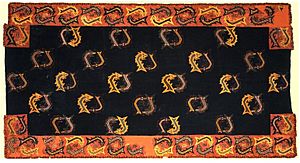
The Nazca are also known for their very complex textiles. Women likely wove these textiles at home. They used spun cotton and wool. They probably used a backstrap loom, similar to how textiles are woven in the region today. Textile designs often appeared earlier than they did on pottery. The dry desert has preserved many textiles from both the Nazca and Paracas cultures. These textiles teach us a lot about early weaving in the region.
Archaeologists have found shawls, dresses, tunics, belts, and bags at Cahuachi and other sites. Many Nazca textiles were found with bodies in burial sites. Almost every body was wrapped (sometimes partly) in a textile as part of the burial ritual. Even piles of bones were found wrapped in textiles. The collections of dresses and shawls included both fancy garments (with feathers, paint, embroidery) and plain ones. This suggests different social roles or responsibilities.
The "Paracas Textile" is a beautifully preserved textile from the Early Intermediate period (300 BC-100 AD). It is one of the finest known textiles. This textile, also called BMT, is in the collection of the Brooklyn Museum. It measures 62x148 cm. It is made of cotton and camelid fibers using several techniques. The middle part is a very fine gauze weave. It was likely woven on a back-strap loom. The warp and weft threads are made of cotton. This central part has 32 repeating rayed heads in six different colors. The colors were made by carefully wrapping dyed camelid fleece around the warp threads. This created a fabric that looks the same on both sides.
The perfect symmetry of the design is broken on the long edges. One side has extra spiral designs, and the other has stepped triangles. If the semi-transparent cloth were folded lengthwise, these edges would meet to form a stepped fret design. This design was common in both Andean and Central American art. The three-dimensional edging is a colorful parade of 90 highly detailed characters. This edging is made of camelid yarn using a cross-knit looping method. Warriors or lords with war gear, women, and shamans, plus two llamas, walk around the edge on a red band. This band is attached to the central woven part with colorful flowers. The backs and fronts of the figures are mirror images, except for three figures. Besides the figures, there is a lot of plant life shown, which is typical in Nazca textiles. The three-dimensional edging attached to the light middle section suggests this mantle was never hung. It was likely laid on the ground and used for telling the future. Lois Martin, who studied the mantle, thinks it might have been used as a calendar to track when rituals should happen.
Mary Frame's study of textiles from Cahuachi has taught us more about Nazca women. She noted that women are rarely recognized in archaeological records. However, Nazca women had access to high-status materials. They also had the right to wear sacred images on their clothes. This showed their status. Many dresses found showed birds with speckled bodies, two-headed snake figures, and human-like figures.
The Mysterious Nazca Lines
The geoglyphs of Nazca, or "Nazca Lines", are huge drawings on the desert floor. They include geometric shapes, miles of lines, and large animal figures. Some are as big as a football field! Many ideas have been suggested about these giant drawings.
Experts believe they were made by large, organized groups of people. This took a long time. It shows that the Nazca had a complex society that could plan such big projects. Researchers have shown how this might have been done. By stretching a rope between two posts and removing the reddish pebbles along the rope, the lines could be made. The lighter earth underneath would then show through. This made the lines visible from high up. Because the geoglyphs were built simply, normal rainfall would have easily washed them away. But the dry desert has kept them safe for hundreds of years.
The purpose of the lines is still debated. Some researchers think they were made for the gods to see from above. Others suggest they were a type of calendar. They might have used astronomical alignments to help with planting and harvesting crops. Still others believe the lines were paths for important ceremonial parades. Experts from different fields have studied the lines. Anthropologists, archaeologists, and astronomers have all looked at them. But they haven't found a final answer for their purpose.
Skull Surgery and Shaping
Trephination was a type of ancient skull surgery used by the Nazca. It helped relieve pressure on the brain from battle wounds or for ritual reasons. This involved removing one or more pieces of bone from the skull while the person was still alive. Evidence of trephination has been seen in excavated skulls. Some skulls show signs of healing. This means the person survived the operation.
Longer skulls, caused by skull manipulation, were also found in excavations from Cahuachi. This was done by tying a cushion to a baby's forehead and a board to the back of the head. Archaeologists can only guess why this was done to some skulls. Some ideas suggest it created a group identity, helped form the person into a social being, or showed social status.
Some historic Native American cultures in North America also shaped skulls. Examples include the Snake, Cowlitz, and Chinook peoples. Most of them lived west of the Columbia River. They were sometimes called the Flathead peoples.
Images for kids
See also
 In Spanish: Cultura nazca para niños
In Spanish: Cultura nazca para niños


